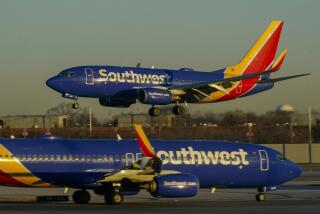Flying with someone? You may have to pay extra to sit together
- Share via
When David Masunaga flew on United Airlines from Honolulu to Paris recently, a passenger traveling with his young son asked if he wouldn’t mind switching seats. As is often the case these days, the father and child couldn’t get seat assignments together, and Masunaga, who teaches high school math in Hawaii, was presented with a carefully curated bag of snacks as a thank you for trading. “It was wonderful,” he says. “I had lots of stuff to nosh on while waiting for my connecting flight.”
Finding seats together when you fly isn’t always easy these days unless you pay sometimes exorbitant fees for “main cabin extra,” “economy plus” or other “preferred” economy seats because that’s all that’s available when booking a flight.
What’s causing this? Many U.S.-based airlines hold back a large number of “standard” economy seats even if the flight is half empty. They do this in part to accommodate their best customers (if you have status in a frequent flyer program, you can usually get first crack at those coveted aisle seats) and in part to earn extra revenue from people willing to pay for the extra legroom seats at the front of economy class, or to pay for any seat assignment at all. On some heavily trafficked flights, if you book close to departure you might only find scattered single seats available in the “regular economy” section, but lots of seats in the “plus” section for an upcharge that can cost $50 or more each way. Even if you book far ahead, even if the flight isn’t sold out, only middle seats or premium seats are shown as available.
I’m all for airlines making a profit, and lately they are doing a pretty good job of it. But this is one way they earn revenue that’s particularly controversial.
And it’s not just parents with small kids. What about someone traveling with an autistic adult, or with an older passenger suffering from dementia? Caregivers absolutely need to be in close proximity with their charges when they fly together. No 3-year-old or special-needs adult is going to enjoy a flight sitting alone between two strangers (the two strangers won’t enjoy it either).
Some tips to get seats together:
Book as far ahead as possible. Almost too obvious to mention, and this isn’t always possible, but it helps.
Enter your child’s age when making a reservation. You won’t get a discount, but one major airline told me that if a child is 12 or younger its computer system will automatically attempt to pair an accompanying adult in an adjacent seat the day before departure. Other airlines may do this too.
Speak to the airline. If you can’t find seats together online, call the airline to see if they’ll open up adjacent seats.
Get to airport very early. If none of the above worked, speak to the check-in agent at the airport. The earlier you do this before departure, the better your chances of snagging a seat that might be held back for elite status passengers.
Change plans or airlines. Choose flights offering seats together, even if that means changing plans or buying a more expensive flight. Or fly on Southwest, which doesn’t offer seat assignments, but gives priority boarding to parents with kids 4 years old or younger and people with special needs.
Bribe someone to switch. None of the above worked? A Starbucks gift certificate, round of drinks or a movie pass might do the trick.
What else can we do?
These strategies don’t always work, or they’re not always practical. That leaves ...
Shut up and pay up. As one cold-hearted “frequent flyer” blogger suggests, it was your choice to have kids, so pay for “preferred” seat assignments if that’s all that’s left. Consider it just another child-related expense along with diapers, child care and college tuition.
Change airline policies. Airlines could stop holding back seats or accommodate passengers with special needs. British Airways is the only airline I’m aware of that has a policy (https://www.britishairways.com/en-us/information/family-travel/getting-ready-to-fly) that promises all children in your booking will be seated with an accompanying adult.
Regulation or legislation. New York Rep. Jerry Nadler introduced a bill (the “Families Flying Together Act of 2012” H.R. 6124) to require airlines to accommodate families with small kids but nothing has happened.
Passengers could do the right thing. See a child or elderly person sitting apart from his caregiver? Switch seats without being asked. Even without a bribe.
But none of this is ideal.
Airlines aren’t about to give up the revenue that their current business model provides.
Sometimes no one takes the bribe. Most passengers want the seat they were assigned. Flight attendants usually try to reseat passengers, but doing so can be stressful and unsuccessful. (Recently I spoke with Cindy Decker, the Columbus Dispatch’s travel editor, who received a complaint from a parent flying on United who was, according to the reader, forbidden to trade seats by a flight attendant).
And legislation or regulation is fraught with issues. How exactly would this work? How old is a “child” (H.R. 6124 says it’s 12 or under) and how do you prove the child’s age, when booking a seat or showing up for a flight (kids don’t have picture IDs; would people try to scam the system like they do with early boarding where that still exists?). What if there’s an equipment change or cancellation and only middle seats are left on the substituted flight or aircraft? Do you kick out people who, months ago, reserved an aisle seat into a middle seat to accommodate families with children or other caregivers and their charges?
Feel free to share your own strategies and suggestions.
(George Hobica is founder of the low-airfare listing website Airfarewatchdog.com.)
(c)2014 Airfarewatchdog.com
Distributed by MCT Information Services
More to Read
Sign up for The Wild
We’ll help you find the best places to hike, bike and run, as well as the perfect silent spots for meditation and yoga.
You may occasionally receive promotional content from the Los Angeles Times.






